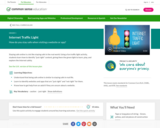
Teach language, vocabulary and listening comprehension with Celebrity Vocab clips! [1:49]
- Subject:
- Arts
- English Language Arts
- Material Type:
- Audio/Video
- Provider:
- PBS LearningMedia
- Date Added:
- 12/01/2022

Teach language, vocabulary and listening comprehension with Celebrity Vocab clips! [1:49]
![ArtsNow Learning: Moving Shapes [PDF]](https://openspace.infohio.org/static/newdesign/images/materials/default-thumbnail-index.png)
These activities will allow students to discover the concepts of geometry through shape exploration and the creation of choreographic sequences.

Learning to engage in collaborative conversations allows children to learn about their world, to become familiar with words, and to build a solid foundation for the development of reading and writing skills. This lesson will model collaborative conversations and give students a chance to practice this skill. Videos of the lesson in action and a poster for the classroom are included.

In this lesson, students will be able to recognize and ask questions using standard question words while learning about bats. Included in this lesson are samples of student work, and pictures of the lesson in action.

How do I convince others to understand my side of the story? Second grade students conducted shared research activities and participated in a Socratic Seminar practicing the techniques of persuasive reasoning.

It is very important to build a class community where all students feel valued and safe. This activity will do just that and you will address the Common Core speaking and listening standards. Students will get to know each by discussing what they've brought in their "Getting to Know You Bag". A letter template and video of the lesson in action are included.

Students will answer text-dependent questions for the expository text "Seasons and Weather". While text-dependent questions have been around for a long time, Common Core asks teachers to focus on them during reading. This lesson includes a powerpoint titled "Weather and Seasons" with specific questions for each page.

One important aspect of the common core is to prepare students to be able to participate in conversations and contribute accurate and relevant information. In this lesson, students listening skills will evolve as they translate verbal instructions into a tangible result. Included are pictures and videos of the lesson in action, and a kite template.

Once students realize they are able to gain more information and expand their learning by asking questions, they love to use their question words. In the end, the more students ask, the more they will have to answer; therefore, the more they learn! In this lesson, students will understand and use question words, like who, what, where, when, why, how, over time.

Creating a product and illustrations make this lesson great for teaching about questioning. Students will ask and answer questions about a text via the assistance of a graphic organizer.

Creating a product and illustrations make this lesson great for teaching about questioning.

Roll cubes to make answering questions. It's an exciting and engaging lesson.

Your children will gain practice recalling details from what they read in the text.

Contains plans for a language activity called "Guess What's in the Bag." Students try to guess the object in a bag in order to develop descriptive language, listening, and problem solving skills. In addition to objectives and standards, this instructional plan contains links to sites used in the lessons as well as assessment and reflection activities.

Why is it important to listen to your feelings when using technology? This foundational digital citizenship lesson challenges kids to pay attention to their feelings while using tech. With an engaging emoji game, students learn practical strategies for managing their feelings -- good, bad, and everything in between. Approximately 30 mins.
LESSON OBJECTIVES: Recognize the different kinds of feelings they can have when using technology. Know what to do when they don't have a good feeling when using technology.

How do you stay safe when visiting a website or app? Staying safe online is a lot like staying safe in the real world. Using a fun traffic light activity, students learn how to identify "just right" content, giving them the green light to learn, play, and explore the internet safely. Approximately 35 mins.
LESSON OBJECTIVES: Understand that being safe online is similar to staying safe in real life. Learn to identify websites and apps that are "just right" and "not right" for them. Know how to get help from an adult if they are unsure about a website.

How can we be safe, responsible, and respectful online? From our head down to our toes, and our feet up to our nose, the Digital Citizens teach students how to be safe, responsible, and respectful online. Approximately 25 mins.
LESSON OBJECTIVES: Understand the importance of being safe, responsible, and respectful online. Learn the "Pause & Think Online" song to remember basic digital citizenship concepts.

Ernie sings a song about wondering. He wonders why a falling star falls and where it goes when it falls. Sometimes he wonders how and why bumblebees fly. This video teaches questioning and observation. [1:52]

A list of "Bear picture books," is found here, as well as suggestions for bear activities, lessons and projects.